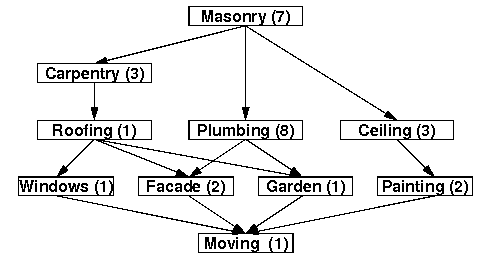Describe the Problem--Example 1
 PREVIOUS
NEXT
PREVIOUS
NEXT
| IBM ILOG Scheduler User's Manual > Getting Started with Scheduler > Using the Building Blocks > Satisfying Temporal Constraints > Describe the Problem--Example 1 |
Describe the Problem--Example 1 |
INDEX
 PREVIOUS
NEXT
PREVIOUS
NEXT
|
The following example illustrates the use of Scheduler on the problem of planning the construction of a house. For each activity in the project, the following table and Figure 3.1 show the duration of the activity in days along with the activities that must precede it.
Solving the problem consists of determining the least possible makespan for the project, that is, the least possible amount of time that elapses between the beginning of the first activity (masonry) and the end of the last activity (moving).

| © Copyright IBM Corp. 1987, 2009. Legal terms. | PREVIOUS NEXT |